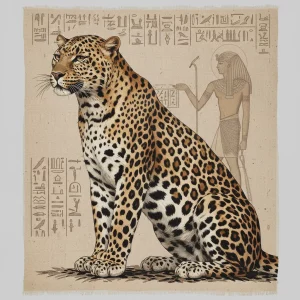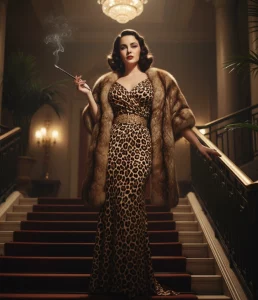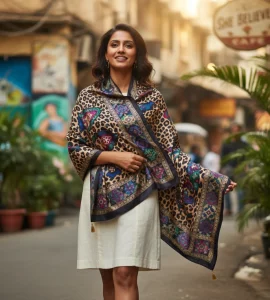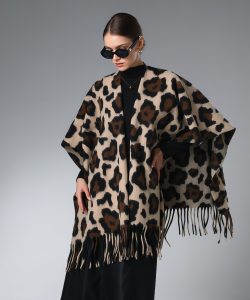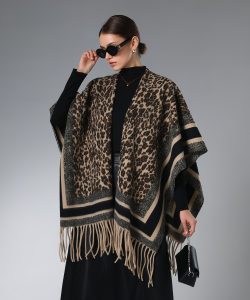The History of Leopard Print
Leopard print, a pattern imbued with wild allure and luxurious elegance, has endured in fashion, appearing everywhere from the runways to the streets. Today, we delve into the origins and evolution of leopard print, and how it has become part of the diverse story of the She Believes shawl.
The Prehistoric Origins of Leopard Print: The Art of Camouflage in Nature
The history of leopard print dates back to the earliest days of human civilization. In ancient times, leopards, with their distinctive spotted patterns, became top predators in the forests, providing them with perfect camouflage in their natural environment. As hunter-gatherers, our ancestors gradually recognized the power and beauty of this pattern.
Originally, people wore animal skins for warmth and survival. Leopard skin, due to its rarity and unique visual effects, has often been associated with power, status, and mystique. Tribal leaders and shamans often used leopard skins as adornments to demonstrate their authority and ability to communicate with spirits. From murals of ancient Egyptian pharaohs to the traditional clothing of African tribes, leopard print is a ubiquitous symbol of royalty, divinity, and courage.
Leopard Print in Ancient Civilizations: A Symbol of Power and Divinity
In ancient Egypt, leopard print was considered a sacred symbol, closely associated with gods and pharaohs. For example, Anubis, the god of the underworld, was often depicted with leopard-spotted animals. Pharaohs also frequently wore leopard-print jewelry to demonstrate their supremacy.
Meanwhile, in ancient Greek and Roman mythology, Dionysus (Bacchus) and his followers, the Maenads, often wore leopard skins. This not only symbolized their wildness and unrestrained nature, but also represented a connection to the forces of nature.
Leopard Print Enters Western Fashion: A Revival of Wild Glamour
Over time, leopard print evolved from simple animal fur to a textile print. In the 18th century, European aristocrats developed a passion for exotic styles, and leopard print, as an exotic motif, began to appear in their clothing.
However, it was the Golden Age of Hollywood in the early 20th century that truly propelled leopard print to the forefront of fashion. Those glamorous actresses, sporting leopard-print coats and gowns, equated leopard print with sexiness, luxury, and confidence.
The trend quickly spread, making leopard print one of the most popular fashion elements of the time.
The Diverse Evolution of Leopard Print: From Rebellion to Classicism
In the mid-to-late 20th century, leopard print underwent an even more diverse evolution in fashion.
• 1950s: Elegance and Sensuality. Christian Dior incorporated leopard print into his designs for his “New Look” collection, launched in 1947, making it synonymous with elegance and sensuality. He even used leopard print as the packaging for his signature perfume bottle.
• 1960s: Rebellion and Rock ‘n’ Roll. With the rise of rock music and the rebellious spirit of youth culture, leopard print took on new meaning. No longer simply a symbol of luxury, it became a way to express individuality and break free from convention. Rock icons like Mick Jagger, frontman of the Rolling Stones, wore leopard print to showcase their irreverent style.
• 1980s: Power and Glamour. In the 1980s, which emphasized strength and confidence, leopard print once again became a fashion staple. Leopard print on padded coats and bodycon dresses exuded a powerful, feminine presence.
• 1990s to Present: Classics and Innovation. Entering the 1990s, leopard print gradually shed its “flashy” label and became a fashion classic. Major brands annually released leopard-inspired designs, effortlessly incorporating it into clothing, shoes, bags, and accessories, showcasing a variety of styles. From simple leopard print accents to extensive, all-over leopard prints, it exudes a unique charm.
Leopard Print and Shawls: The Perfect Combination of Fashion and Practicality
Leopard print shines so well in accessories like shawls and scarves for several reasons:
1. Timeless: As a classic pattern, leopard print never goes out of style. A leopard print shawl remains fashionable, regardless of changing trends.
2. Versatile: A leopard print shawl can be easily paired with a variety of outfits. Whether paired with a simple solid-color top or classic jeans, a leopard-print shawl can instantly elevate any outfit. It can liven up a dull outfit or enhance a sophisticated look.
3. Expressing Personality: Leopard print inherently carries a strong personal touch, and choosing a leopard-print shawl showcases the wearer’s confidence and unique fashion sense.
4. Visual Impact: Leopard print’s distinctive spots create a powerful visual impact, instantly drawing attention and becoming the focal point of any outfit.
At She Believes, we understand the rich stories and multicultural significance of leopard print. We don’t just create shawls; we tell a story and convey a belief through each product. A leopard-print shawl is more than just a fashion item; it embodies the beauty of wildness, the source of strength, the light of confidence, and a woman’s pursuit of freedom and independence.


